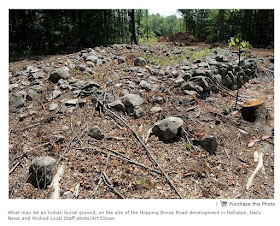By Bill Shaner
Daily News staff
"HOLLISTON – Along the edge of woods that crews have recently
cut to expand the Hopping Brook Business Park sat a pile of stones unlike the
uprooted boulders and tree trunks in which it surrounded.
The stones were laid in an oval-shaped mound. The mound had
rounded edges that wrapped around a depression in the center. Overgrown and
worn, with faded moss on the granite rocks, the mound had clearly been there
for years. Some would argue it's been there for centuries.
A small but resolute group of archaeologists, historians and
activists believe the mound is one of thousands of similar artifacts, sometimes
called rock piles, that predate white settlers. Left by native people, experts
believe they were created for spiritual purposes, perhaps for burial or other
ceremonies.
And soon, that one particular mound in Holliston will be
gone.
The mound on Tuesday afternoon resembled an island,
surrounded by hundreds of acres of deforested land. Crews had already removed a
mound next to it, said Joanne Hulbert, town historian.
“That's pretty much the sad tale of it,” said Hulbert.
“Bulldoze it over, the march of progress, and a little vestige of Native
American evidence goes away once more.”
When the 200-acre development, essentially a delayed second
leg of the Hopping Brook Business Park, is complete, the mound will make way
for a road or a parking lot, foundation for an office space or a warehouse.
Construction started about a month ago.
Standing by the mound, Matthew Howes, a Holliston man who's
helped archaeologists discover and register native landmarks in the area,
lamented the fact it would disappear.
“People need to kind of wake up and realize that native
people were here for thousands of years … and their remains are everywhere,” he
said.
There are hundreds of similar mounds in the area, and those
who are passionate about native histories want to see more thought given to
their preservation.
Curtiss Hoffman, a Bridgewater State University professor,
has inventoried about 5,100 similar mounds all along the Eastern Seaboard, from
Georgia to Nova Scotia. The mounds, he said, often sit in clusters – 50 or so
built very close to one another. It's something he feels isn't an accident.
The only way to truly save the mounds is to have state
preservation offices acknowledge them as historic, and include them in state
registries. Until then, he said, local ordinances and land acquisitions to
preserve the mounds are the most effective method.
But before that happens, there needs to be consensus in the
archaeological community. Some feel the mounds are the product of colonial
farmers removing rocks from farmland. Hoffman feels the mounds are too
deliberate, too ornate in their arrangement, for that to be legitimate."
Bill Shaner can be reached at 508-626-3957 or at
wshaner@wickedlocal.com. Follow him on Twitter @bill_shaner.



Thanks to Matt Howes for getting this reported.
ReplyDeleteWhen the only presidential candidate I have ever voted for happens to be Ralph Nader, I suppose whistle-blowing is in the blood.
ReplyDeleteThe stone mound looks like a dilapidated platform cairn. Is there no way to save it at this point, or at least have archaeologists do some minor excavation before the whole structure is torn apart? Of course, most archaeologists dismiss such features as colonial field clearing, and thus not worthy of preservation.
ReplyDeleteThis is not a platform cairn, Norman. It is unlike any feature I have seen before and really there are no comparisons. I was the one who found it years ago (I believe) so I have seen it first hand and can attest that it is quite unusual. There are some large mounds with hollows and other rock piles near to it that are commonly found but this one particular feature is unique. I'm assuming it has already been bulldozed as the developer's plan I got from the town years ago showed a road going right through the middle of this feature.
ReplyDeleteI agree it is not a platform, the interior depressions are regular, although not easy to see in the pictures. I also agree that it is pretty unique. There are a couple, a bit like this, near Fitchburg: one on South Manoosnoc, and another near the top of Falulah Brook.
ReplyDeleteI have seen many like this. Made of earth and stone. It resembles the serpents head. Sorry serpent mound is not the only serpent mound. As of last count there is over 100 know at this time. there are more out there. shamed this was not excavated before they dozed it into oblivion. lest than there would be a record.
ReplyDelete